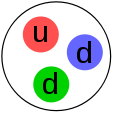
Neutron diffraction

Neutron diffraction or elastic neutron scattering is the application of neutron scattering to the determination of the atomic and/or magnetic structure of a material. A sample to be examined is placed in a beam of thermal or cold neutrons to obtain a diffraction pattern that provides information of the structure of the material. The technique is similar to X-ray diffraction but due to their different scattering properties, neutrons and X-rays provide complementary information: X-Rays are suited for superficial analysis, strong x-rays from synchrotron radiation are suited for shallow depths or thin specimens, while neutrons having high penetration depth are suited for bulk samples. Neutron diffraction or elastic neutron scattering is the application of neutron scattering to the determination of the atomic and/or magnetic structure of a material. A sample to be examined is placed in a beam of thermal or cold neutrons to obtain a diffraction pattern that provides information of the structure of the material. The technique is similar to X-ray diffraction but due to their different scattering properties, neutrons and X-rays provide complementary information: X-Rays are suited for superficial analysis, strong x-rays from synchrotron radiation are suited for shallow depths or thin specimens, while neutrons having high penetration depth are suited for bulk samples. The technique requires a source of neutrons. Neutrons are usually produced in a nuclear reactor or spallation source. At a research reactor, other components are needed, including a crystal monochromator, as well as filters to select the desired neutron wavelength. Some parts of the setup may also be movable. At a spallation source, the time of flight technique is used to sort the energies of the incident neutrons (higher energy neutrons are faster), so no monochromator is needed, but rather a series of aperture elements synchronized to filter neutron pulses with the desired wavelength. The technique is most commonly performed as powder diffraction, which only requires a polycrystalline powder. Single crystal work is also possible, but the crystals must be much larger than those that are used in single-crystal X-ray crystallography. It is common to use crystals that are about 1 mm3. Summarizing, the main disadvantage to neutron diffraction is the requirement for a nuclear reactor. For single crystal work, the technique requires relatively large crystals, which are usually challenging to grow. The advantages to the technique are many - sensitivity to light atoms, ability to distinguish isotopes, absence of radiation damage, as well as a penetration depth of several cm Like all quantum particles, neutrons can exhibit wave phenomena typically associated with light or sound. Diffraction is one of these phenomena; it occurs when waves encounter obstacles whose size is comparable with the wavelength. If the wavelength of a quantum particle is short enough, atoms or their nuclei can serve as diffraction obstacles. When a beam of neutrons emanating from a reactor is slowed down and selected properly by their speed, their wavelength lies near one angstrom (0.1 nanometer), the typical separation between atoms in a solid material. Such a beam can then be used to perform a diffraction experiment. Impinging on a crystalline sample, it will scatter under a limited number of well-defined angles, according to the same Bragg's law that describes X-ray diffraction. Neutrons and X-rays interact with matter differently. X-rays interact primarily with the electron cloud surrounding each atom. The contribution to the diffracted x-ray intensity is therefore larger for atoms with larger atomic number (Z). On the other hand, neutrons interact directly with the nucleus of the atom, and the contribution to the diffracted intensity depends on each isotope; for example, regular hydrogen and deuterium contribute differently. It is also often the case that light (low Z) atoms contribute strongly to the diffracted intensity, even in the presence of large Z atoms. The scattering length varies from isotope to isotope rather than linearly with the atomic number. An element like vanadium strongly scatters X-rays, but its nuclei hardly scatters neutrons, which is why it is often used as a container material. Non-magnetic neutron diffraction is directly sensitive to the positions of the nuclei of the atoms. The nuclei of atoms, from which neutrons scatter, are tiny. Furthermore, there is no need for an atomic form factor to describe the shape of the electron cloud of the atom and the scattering power of an atom does not fall off with the scattering angle as it does for X-rays. Diffractograms therefore can show strong, well-defined diffraction peaks even at high angles, particularly if the experiment is done at low temperatures. Many neutron sources are equipped with liquid helium cooling systems that allow data collection at temperatures down to 4.2 K. The superb high angle (i.e. high resolution) information means that the atomic positions in the structure can be determined with high precision. On the other hand, Fourier maps (and to a lesser extent difference Fourier maps) derived from neutron data suffer from series termination errors, sometimes so much that the results are meaningless. Although neutrons are uncharged, they carry a magnetic moment, and therefore interact with magnetic moments, including those arising from the electron cloud around an atom. Neutron diffraction can therefore reveal the microscopic magnetic structure of a material. Magnetic scattering does require an atomic form factor as it is caused by the much larger electron cloud around the tiny nucleus. The intensity of the magnetic contribution to the diffraction peaks will therefore decrease towards higher angles.
